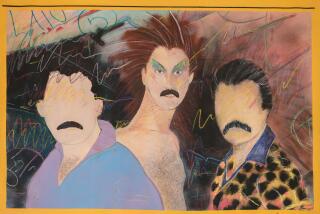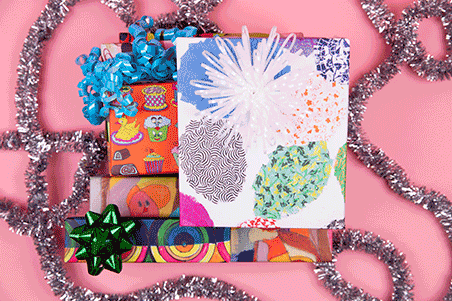Object Lesson: Hallucinatory collages tell the story of the U.S.-Mexico border
As far as art forms go, it doesn’t get more lowbrow than lenticulars, the 2-D printed pictures that, with the aid of a rippled, plasticized coating, appear three dimensional, often with animated effects. Think of those thrift store portraits of Jesus that appear to be winking.
Artists Jamex and Einar de la Torre have used this technology — generally reserved for popular religious art and advertising campaigns — to fantastic effect.
In fact, a current show of their work at Koplin Del Rio in Culver City offers a bounty of pieces that employ the device. Among them: a mandala-type design studded with images of skulls, anatomical sketches and religious iconography and a Last Supper-style scene in which the disciples’ faces have been replaced with those of the artists. (I made a Vine of the former, to capture the trippy sense of movement these pieces have when you see them in person.)
SIGN UP for the free Essential Arts & Culture newsletter >>
Among the most elaborate works are a pair of lenticulars that take on the U.S.-Mexico border as their subject: “Rites of Passage,” shown at top, and “Border Park of Earthly Delights,” both of which were made in 2014. (Unfortunately the images shown here don’t capture the works’ psychedelic effects, which is why it’s best to see them in person.)
The brothers, who were born in Guadalajara but completed their high school and university studies in Orange County and Long Beach respectively, spend a lot of time on the border. They have a home in San Diego but maintain their studio in the Valle de Guadalupe, just inland from Ensenada.
“The border is so misunderstood,” Einar says via telephone from the pair’s Mexico studio. “It’s too much of a caricature for so many people. It’s seen as a line that keeps people from crossing. But the border is a really dynamic place.
“There’s a tremendous amount of people who work on one side and then live on the other side,” he says. “It used to be that the people who lived on the Tijuana side would work on the San Diego side. But when the violence peaked years ago, a lot of rich people from Tijuana moved to Chula Vista and they go to Tijuana to work.”
The pieces in the show capture the border as a hive of strange and surreal activity.
“Rites of Passage” is based on an actual photo of the border that the brothers took in the vicinity of Tijuana’s airport. To that they added long lines of dolls and religious figures and bits of historic paintings. Figures on the Mexican side re-emerge as meat in the U.S.
In the foreground, a set of well-dressed figures guard a special entrance. “That’s Sentri,” Einar says, chuckling, referring to the special U.S. Customs and Border Protection Service program that allows pre-approved travelers to cross the border without having to endure the legendarily long lines.
“Border Park of Earthly Delights” is also based on an original photograph, this one of the beaches that line the border wall as it dips into the Pacific Ocean. On the California side is Border Field State Park, a nature preserve.
“The park,” says Einar, “was this place where people from both sides would be able to get together. That never happened.”
To this photo, the brothers added images by 15th century Netherlandish master Hieronymus Bosch, renowned for his surreal hellscapes, full of bizarre creatures and unsettling scenes. (The title of the work pays tribute to Bosch’s “Garden of Earthly Delights.”) Though, naturally, the brothers add their own flourishes, such as a spit that dispenses roasted al pastor meat for tacos amid a clutch of writhing Boschean figures.
“We put Bosch’s hell images on the Mexican side,” says Einar. “And the tiny images you see on the U.S. side are images from Bosch’s heaven painting. But it’s really the images from hell that are more interesting.”
Not that they’re necessarily equating Mexico with hell.
“You can be in heaven wherever you are,” says Einar, “as long as you have money.”
Einar and Jamex de la Torre, “Quemando Las Naves,” is on view at Koplin del Rio through Aug. 29. 6031 Washington Blvd., Culver City, koplindelrio.com.
Find me on Twitter @cmonstah.
MORE:
What will become of Palmyra ruins after Islamic State killing of Syrian archaeologist?
Art swap: That 50-cent thrift-store painting? It might be a Lorenzo Hurtado Segovia original
MoMA does Latin American architecture: the High-Low chat with Alexandra Lange
More to Read
The biggest entertainment stories
Get our big stories about Hollywood, film, television, music, arts, culture and more right in your inbox as soon as they publish.
You may occasionally receive promotional content from the Los Angeles Times.







